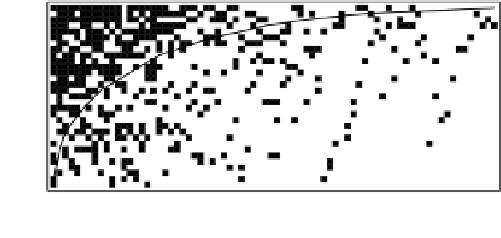Information Technology Reference
In-Depth Information
(A)
(B)
1
2
3
4
5
6
7
8
9
10
1
2
3
4
5
6
7
8
9
10
1
2
3
4
5
6
7
8
9
10
1
2
3
4
5
6
7
8
9
10
Animals
Animals
(C)
5
10
15
20
25
30
5
10
15
20
25
30
35
40
45
50
55
60
65
70
75
Animals
Fig. 14.4. The nested structure of mutualistic networks. The mutualistic network is now repre-
sented in matrix format, where rows represent plants, columns represent animals, and a square
indicates an interaction between that plant and animal. (A) represents a perfectly nested ma-
trix, where specialist species interact with well-dened subsets of the species generalists interact
with, (B) represents a similar matrix with interactions randomly shued, and (C) shows a real
mutualistic network where the continuous line indicates the isocline of perfect nestedness. (Figure
modied from Bascompte et al. (2003).)
This asymmetry in specialization, independently reported by Vazquez and Aizen
(2004), is also evident when looking at weighted networks. The weight of a link
indicates the intensity of the mutualistic eect or dependence of one species on
another. The bulk of dependencies between species are quite weak, but a few are
strong. In the few cases in which, for example, a plant depends strongly on an
animal, the animal depends on the plant very weakly, and vice versa [Bascompte
et al. (2006)]. That is, pair-wise interactions are very asymmetric. Similarly, one
can also look at the quantitative extension of species degree, species strength. The
strength of a plant species, for example, is the sum of all dependencies of the animals
which depend on that plant. It describes the importance of a species from the point
of view of those in the other set. Species strength varies widely across species
[Bascompte et al. (2006)]. As for binary data, mutualistic networks are also very
heterogeneous in the distribution of species strength.
14.3.2. Assembly of mutualistic networks
So far, we have provided a descriptive account of mutualistic networks. The dy-
namics, as always, are more complicated to tackle from the experimental point of










